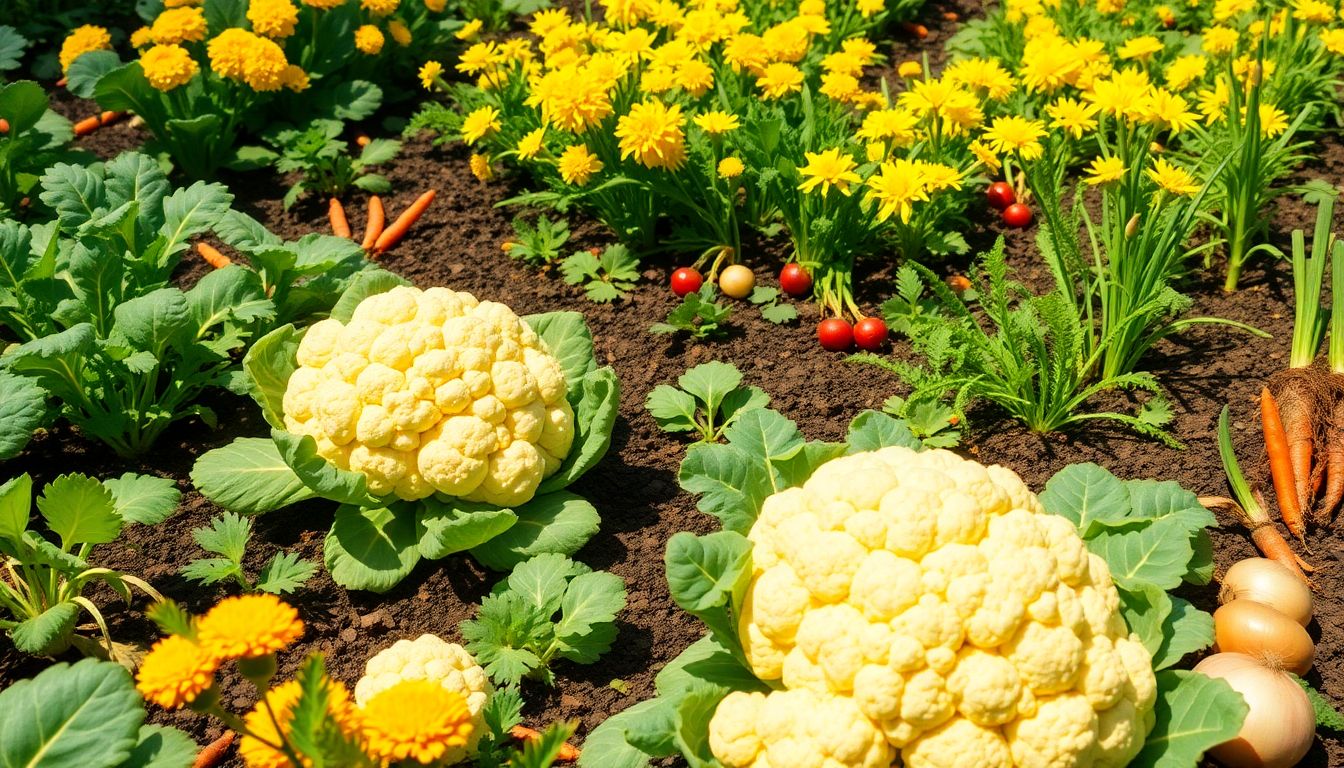Growing cauliflower is quite an arduous task. Cabbages are affected by pests which can ruin your harvests because of diseases. It is very hard for cauliflowers to thrive in poor soil. But there is a natural method to help, known as companion planting, making growing a variety of crops easier: the arrangement of native and other plants so that they thrive strong and healthy with one another.
The value of companion planting is to exploit the power of partnerships among plants. Some plants have a great relationship with cauliflower; they repel pests and improve the soil. This guide explains how to use companion planting to get that beautiful cauliflower harvest.
Companion Planting for Cauliflower: Understanding It
Companion planting is like an entire plant support system. It is another way of growing different plants close to one another so that they help each other in growing using their resources-they can protect one another, they can improve the soil. It’s one smart way of gardening.
Companion Planting: What it Is
Companion planting is all about creating a miniature ecosystem in your garden. Plants too benefit for each other. They may deter pests with some plants, while some may draw good bugs in. Legumes may add the nitrogen to the soil that helps other plants. This is indeed a scented, ecological way of gardening. The garden becomes even better healthy and productive.
Benefits of Companion Planting for Cauliflower
The many possible benefits of companion planting. Pests are generally kept at bay naturally. Certain plants act as wardens against harmful insects. Enriches soil; grows better. Some companions add nutrients yielding nitrogen and carbon dioxide to other cauliflowers. The result raises harvests. Healthy plants yield more cauliflower-an entire win-win as far as your garden goes!
Best Companion Plants for Cauliflower
There are a few plants that really do make great companions for cauliflower-bringing specific benefits. They can really make a huge difference in your garden. Try out some of these pairings.
Herbs: Rosemary, Thyme, and Sage
Rosemary, thyme, and sage are so helpful for cauliflower when it comes to keeping pests away. The moths and flea beetles hate the smell of these herbs and thus don’t go nearer. These herbs require little care. Just put it up around your cauliflowers for extra protection. Your cauliflowers will benefit from it.
Vegetables: Beans, Peas, and Celery
Beans and peas are great for this purpose. These legumes can fix nitrogen for the soil, which is important for big cauliflower growth. Another choice is celery, which keeps the cabbage white butterflies away from damage on the cauliflower. Plant these all together very lazily around your cauliflowers.
Plants to Avoid Planting Near Cauliflower
Not all plants serve as good neighbors, while some can damage your cauliflower plant, it can as well attract pests or compete for nutrients with your cauliflowers; do avoid them in planning your garden.
Brassicas: Broccoli, Cabbage, and Kale
Don’t even think about growing broccoli, cabbage, and kale nearby since they are brassicas like cauliflower. They attract the same pests and diseases. They compete for the same nutrients in the soil; therefore keeping apart will be best results.
Strawberries
Strawberries do not seem dangerous, but they may stunt the growth of cauliflower. Experts do not know why this happens, and yet many gardeners can assert that it happens. In turn, it is advisable to keep strawberries well away from your cauliflower.
Designing Your Companion Planting Strategy
Planning is very important for a successful companion planting scheme. Think about the sun. Think about the spacing. Make sure the plants work together. A little good design will go a long way.
Planning Your Garden Layout
Give your cauliflower enough space. It needs room to grow big. Companion plants also need space. Don’t overcrowd your garden. Proper spacing ensures healthy plants. This allows each plant to thrive and do its job.
Crop Rotation and Companion Planting
It’s beneficial to rotate your crops each year for other reasons as well: it improves soil health, prevents pest incidents, etc. Continue with your crop rotation and associate it with companion planting for the long-term health of your garden.
Troubleshooting Common Issues
Problems do crop up even where companion planting is concerned. You may see the odd pest. Nutrient problems can pop up. Be ready to tackle any of the above.
Identifying and Addressing Pest Problems
Make sure that you observe your plants. Look for evidence of pests; if you spot them, treat them with an organic measure. The companion plants may help, but you might need some reinforcements. A well-timed insecticidal soap treatment comes in handy.
Addressing Nutrient Deficiencies
Cauliflowers are heavy-feeding crops. They benefit from companion planting, but should there be a need, you could enhance their nutrient acquisition through soil amendment. The fertilizer can serve to restore some crucial nutrients that your cauliflower definitely needs.
Conclusion
Companion planting offers many benefits for cauliflower: Pest control. Soil improvement. Yield enhancement. So start experimenting with combinations and find out what works best in your garden. Plan well, and enjoy your successful harvest of cauliflowers.


